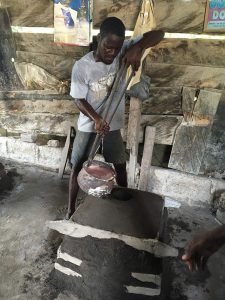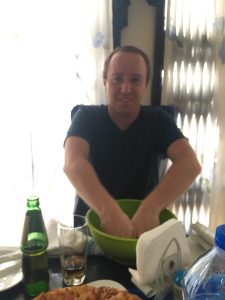by Kelly Fox and Peter Beck (both ’19 B.S., Mechanical Engineering)
(Editor’s note: Four students traveled to Ghana in spring 2019. This is their story with minor edits for style and flow.)

What brought us to Ghana: a groundnut (peanut) roaster
There were four of us on our senior design project: Peter Beck, Kelly Fox, Carter Marr, and Alex Katzung. We were working with a company called Burro in Ghana to make a peanut roaster and the trip was sponsored by Oregon State alumni Dick and Gretchen Evans. We developed our prototype in Oregon and were planning to work on a second iteration in Ghana.
Switching gears. The cassava harvester
Upon arriving to Koforidua, Ghana, we met the whole Burro staff —including finally getting to see our contacts Serwaa and Moses in person. After months of interacting with them over Skype calls and email, we could finally put faces to the names. We settled in to the office, and then had a meeting with them and Whit, Burro’s founder, where we found out we were going to redirect our efforts to building a cassava harvester. We soon learned that this was a common thing here in Africa – plans change and you have to adapt on the spot. For those of you wondering what cassava is, it is a root vegetable that is very calorie dense and drought resistant — perfect for a meal that can be harvested in any season.
Prototyping


Once the cassava harvester design was ready, we got to prototyping! Our first prototype was 3D printed so we could utilize a local handicraft — aluminum casting in sand. We met up with Eric, the sand caster and he let us watch him work. He created a mold from our 3D print, heated up the aluminum over an open fire, and carefully poured each mold.

After making our first prototype, we got to work on the steel one — without the machine shop in Rogers Hall! This meant a lot of grinding, welding, and cutting to get the steel down to size. Our arms were sore after that!
User testing
The best part about the Burro experience was their focus on user testing. They regularly go out and get feedback from villagers to learn how to improve their product. So, we headed out to the field with our cassava harvester!
We met up with a few locals from a nearby village. We hiked up to their farm for the cassava. A few of them were laughing about our new tool along the way. They didn’t think it would work! Once we got up to the cassava though, they went to town on the field. They loved the new tool and kept using it. It was hard to reign them in to ask questions. Eventually we were able to get feedback on various design changes. One of them described the old way of harvesting like dancing a jig rather than actually pulling up the cassava. After the questions, a few of the men went to a nearby tree and gave us a basket full of mangoes to take home — a testament to their generosity!
Actually seeing the tool in use was exciting and gave us more details on how to improve the design. Whitwill be taking this product to its next stage of development.
Experiencing Ghana
When we first got to Ghana, we didn’t know exactly what to do. Our first meal in Ghana, we decided to be adventurous. Peter ordered a dish where he knew what none of the food was (ampesi with palava sauce), and Kelly decided to one up him and get fufu with snails.

Peter tried the palava sauce, and felt it was good but too rich, then he tried the ampesi, which turned out to be yams and plantains, which were too bland. It wasn’t until we experienced the food with our coworkers that we learned how were supposed to enjoy it! They told us to put it together and it soon became our favorite dish.
That brings us to the best part of our trip: our coworkers. They took us to the best places in town to find other local dishes including jollof, banku, and kenkey. When we were eating with Moses, he said, “You are invited,” and we subsequently ate some of his food. He laughed a little and later told us that everyone says that and you don’t necessarily take the food. They welcomed us to join us in experiencing their culture. We were able to share in a variety of events from their funerals to churches to naming ceremonies.
Medassi! (Thank you)
Peter and Kelly
